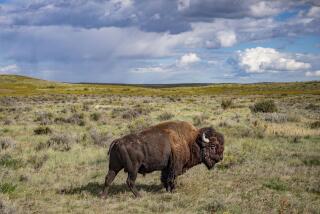Beauty of the Land Takes Center Stage in ‘Lewis & Clark’
- Share via
When Meriwether Lewis and William Clark stood on a crest at the Continental Divide of the United States in the summer of 1805, they were convinced that they had reached the climax of their epic journey to explore the West. What they saw stretching before them, however, was the challenging, seemingly endless grandeur of the Rocky Mountains.
And it is that revelatory moment, the moment at which they realized the true extent of their quest, that best defines the superb, four-hour “Lewis & Clark: The Journey of the Corps of Discovery,” documentarian Ken Burns’ latest picture. It airs tonight and Wednesday on PBS.
Remembered by most as a kind of sidebar fact to be memorized for an American history exam, the Lewis and Clark 2 1/2-year trip was, in fact, a courageous, grueling exploration that became one of the pivotal and illuminating events in the westward expansion of the United States.
Their expedition, which began on May 14, 1804, took them up the Missouri River, across the Rockies and down the Columbia River to the Oregon coast. Like many before them, they failed in an effort to find a much-sought Northwest Passage (a waterway to link the Atlantic and Pacific oceans). What they did was to provide the still-young United States--a country that, at the time, clustered around the Eastern Seaboard--with a sense of its potential continental presence, and the seeds for its eventual belief in a manifest destiny to occupy the land from ocean to ocean.
For Lewis and Clark, however, it was a trip into the unknown. Once beyond the Mississippi, they were in uncharted territory. They were the first U.S. citizens to see the Great Plains and the Rocky Mountains, to cross the Continental Divide and to reach the Pacific Ocean by land.
In many ways, their endeavor was similar to that of the Apollo astronauts who landed on the moon. But there was one notable difference: The astronauts were in virtually constant communication with their home base, while the Lewis and Clark company traveled in complete and total isolation. Their only resources were what they could carry with them, and what they could gather, via trade and friendship, from the numerous Native Americans, who greeted them with almost universal goodwill.
Burns and writer and fellow producer Dayton Duncan prepared themselves for the project by retracing the Lewis and Clark trail. “We froze, we itched, we were rained on, we were lightning-ed on, we were attacked by mosquitoes,” Burns said.
The results, despite the discomforts, were worth the effort. In characteristic Burns style, the story unfolds via archival material, including drawings and pages from the corps’ journals, some impressionistic re-creation shots (usually done in silhouette), and commentary from Duncan (who wrote “Out West: An American Journey Along the Lewis and Clark Trail”) and historian Stephen Ambrose. Narration is by Hal Holbrook, with other voices provided by Adam Arkin, Matthew Broderick, Sam Waterston and others.
Appropriately, the true focus of “Lewis & Clark: The Journey of the Corps of Discover” is the land itself. And Burns’ cinematographers have supplied a stunning series of visuals of the plains, the mountains and rivers--a vast landscape that, even on the television screen, underscores the sense of awe reported by Lewis and Clark in their journals.
Burns’ front-and-center placement of the land reflects his greatest strength as a documentarian--his willingness to allow his material to find its own form of expression. He is, as was amply revealed in “The Civil War,” “Baseball” and “The West,” a prodigious researcher, but his research materials are never presented simply as data piled upon data, fact following fact. They emerge, instead, as the resonant voices of the past.
And by permitting them to speak on their own terms, Burns acknowledges the essential fact that history is life, and life is history.
* “Lewis & Clark: The Journey of the Corps of Discovery” airs 8-10 p.m. tonight and Wednesday on KCET-TV Channel 28. PBS has rated it TV-G (suitable for all ages).
More to Read
Sign up for The Wild
We’ll help you find the best places to hike, bike and run, as well as the perfect silent spots for meditation and yoga.
You may occasionally receive promotional content from the Los Angeles Times.





